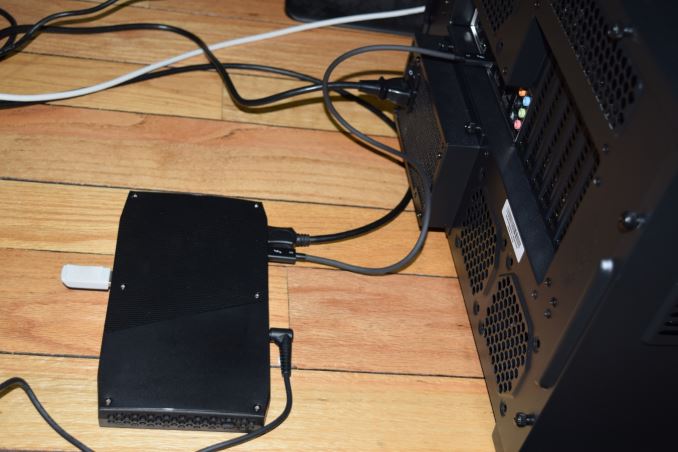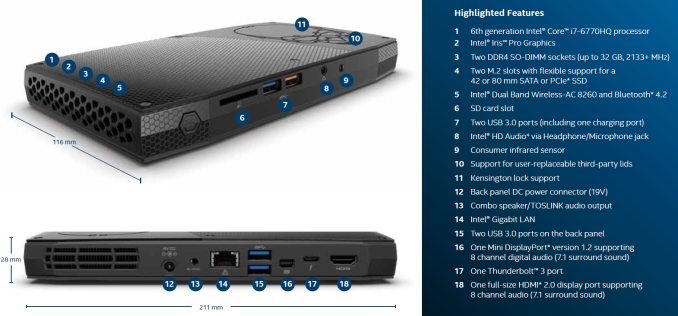The Intel Skull Canyon NUC6i7KYK mini-PC Review
by Ganesh T S on May 23, 2016 8:00 AM ESTMiscellaneous Aspects and Concluding Remarks
One of the more impressive aspects of the Skull Canyon NUC6i7KYK is the reappearance of Thunderbolt in a mini-PC. We have already covered Thunderbolt 3 in good detail. From the perspective of a Skull Canyon evaluation, the Thunderbolt 3 port does deserve a bit of attention. It must be noted that this USB Type-C port can also act as a USB 3.1 Gen 2 host port. Our evaluation of this feature is in two parts - we first hooked up a SanDisk Extreme 900 1.92TB USB 3.1 Gen 2 SSD and ran a quick speed test. We were able to see results similar to our review numbers, indicating that the USB 3.1 Gen 2 mode was indeed active. For the Thunderbolt part, we decided to check out Thunderbolt networking with our direct-attached storage testbed.
A Thunderbolt cable between two PCs is enough to create a Thunderbolt network
Connecting the Thunderbolt ports on the two machines and allowing the PCs to talk to each other automatically creates a 10Gbps network adapter. For a setup with just two machines, it is enough to just set static IPs on the interfaces of both machines in the same subnet, and setting the network location to private so that the machines can talk to each other. We configured a RAM drive on the testbed and mapped it as a network drive on the NUC6i7KYK, Running CrystalDiskMark on the mapped drive showed read speeds of 700 MBps and write speeds of 620 MBps, indicative of a 10Gbps link. The gallery below presents some screenshots of the benchmarks as well as the Thunderbolt networking setup steps.
Moving on to the business end of the review, let us get the complaints out of the way - While the size and form-factor of Skull Canyon are impressive, the acoustic profile is not that great. We would gladly trade a modest increase in the footprint of the system for lower fan noise. That said, the fan noise is in no way comparable to the BRIX Gaming lineup. It is just that it is not as silent as the traditional NUCs.
On the board layout front, we are unable to fathom why the CPU's PCIe lanes are not used at all. It would have been great to have a dual-port Alpine Ridge controller hang directly off the CPU's PCIe lanes. Finally, the ports on the chassis could have done with better spread. The two pairs of USB ports are such that one occupied port ends up making it difficult to utilize the other one in the pair. A port on one of the sides, or, on the lid (without relying on third-party designs), would be very welcome.
But with the above caveats in mind, Skull Canyon is definitely a great product. Simply put, it packs the most punch among systems with similar footprints. It is excellent for casual gamers, but, unfortunately, stops short of being a replacement for systems like the Zotac ZBOX MAGNUS EN970 or the ASRock VisionX 471D - two small form-factor PCs that integrate discrete GPUs at the cost of a larger footprint compared to Skull Canyon. The Thunderbolt 3 port, with an external GPU dock, can somewhat make up for the lack of a discrete GPU for gamers. However, the cost factor becomes a major issue. The 4C/8T configuration of the Core i7-6770HQ is also attractive to consumers looking for a small form-factor system with a powerful CPU, but, they must remember that some price premium is being paid for the Iris Pro graphics.
I am actually looking forward to what vendors like Zotac and ASRock can do with a similar design. If they could take a Skylake-H processor without Iris Pro (say, Core i7-6820HQ), and use the PCIe lanes off the CPU to hook up a mobile discrete GPU, it could deliver the best of both worlds - all the 45W TDP of the CPU can be used to provide raw processing power for CPU-intensive workloads, while a dGPU can handle graphics duties with a separate power budget.
To summarize, Intel has indeed managed to change the game with the NUC6i7KYK. A look at the increase in the gaming capabilities over the previous generation 'gaming' NUCs make the Skull Canyon updates to appear evolutionary in nature. However, the overall platform capabilities (including a much more powerful -H series CPU instead of a -U series CPU, as well as the integration of Thunderbolt 3 and dual M.2 PCIe 3.0 x4 SSD slots) are enough to justify the price premium ($650 for the barebones configuration).


















133 Comments
View All Comments
FlyingAarvark - Monday, May 23, 2016 - link
All of the Skull Canyon reviews so far online have been relative failures. I hate to bash this work but a few points that need to be said.To only test this with 2133Mhz is a shame. Intel stated that 2400Mhz works without a FSB OC and you can run up to 3000Mhz with one. That would change the gaming performance tremendously but not a single site has bothered testing this.
We just didn't learn anything that wasn't easily known from just looking at this on Newegg. We knew it would be really fast for the size/power requirements. We knew it would be fairly hot on-load due to past NUCs. But we didn't know how it would react with DDR4 2400/2800/3000+.
The other problem is that there's concern expressed in the review that bidirectional 4GB/sec bandwidth isn't enough. Its been proven and known if you look into it that PCIE 1.0 x16 (4GB/sec) does not bottleneck a GTX 980. Skull Canyon should be closer to 5GB/sec than 4GB as well. This wasn't tested with a Razer Core, but I think there's a really good change this is the fastest stock gaming CPU on the market today when paired with a discrete GPU due to the 128MB L4. It was shown that Broadwell 5775Cs were already holding that crown in the past.
Considering how incredibly impressive this NUC is already with its small size, low power draw, various Thunderbolt3 options (storage/GPU/docks): both of these points on faster DDR4 and 128MB L4 impact with a dGPU would make it even more impressive than it already is and probably result in slam dunk territory.
I think everyone in the tech community is massively missing the mark on this one! It just hasn't been properly tested. Intel absolutely nailed this product but is failing to properly instruct reviewers on what to test. Send me a sample, forumemail123 at g mail. I'll do it right.
jardows2 - Monday, May 23, 2016 - link
So, you want this product reviewed in tests that will show it in a better light, and ignore all the standard tests that give it an apples-to-apples comparison, showing that Intel has a long ways to go to provide good value to their customers in this market segment?FlyingAarvark - Monday, May 23, 2016 - link
Ah an AMD poverty gamer arrives. Apples to apples against what? Older NUCs? There is no other competition for this small of a form factor. Certainly not from AMDone.I'm asking that the things that all of us who have been so excited about this product have wanted to see. DDR4-3000 IGP gaming performance and Razer Core FuryX or 980Ti performance.
As I noted, this review told me absolutely nothing that wasn't already known just through common sense. No one will buy this thing for a ho-hum NUC, there's already plenty of those. We're buying them for the size/performance combo and going to run 3000Mhz DDR4 or Razer Core with it.
JoeyJoJo123 - Monday, May 23, 2016 - link
Nobody said anything about AMD, dude.jardows2 - Tuesday, May 24, 2016 - link
You just showed your true colors. I am anything but an "AMD poverty gamer." I need to know how this device compares to other computing devices, so I can determine if the small form factor benefit is worth the performance hit. Very few people are going to have a demand for a computer that fits a particular small form factor, and are willing to do anything to hit that size requirement. Most people just want the best value, and size is a component to that.If we are performing tests that show best case scenario for this unit, then we'd have to do the same for every other bare-bones unit. Then there would be no true comparison, and each piece would be no better than a cnet review bought and paid for by the manufacturer, and we would be no better informed.
FlyingAarvark - Tuesday, May 24, 2016 - link
Nice attempt at digging yourself out of that hole: you'd be pissed to see this thing shown in a positive light because as you said supposedly, "Intel has a long ways to go to provide good value". Shows how much you know, just taking the typical fanboy stance on this thing without knowing what you're even looking at- much like this review.The point remains: people want to see this used with varying RAM speeds. It affects the gaming performance greatly due to the IGP. Also people want to see it benched with a 980Ti / 1080 to compare to other high end gaming CPUs.
There's absolutely no reason that's "best case" at all. It's just asking for a full review.
stux - Monday, May 23, 2016 - link
I'm curious if the BIOS supports RAID0/1 and if so, what the performance from dual sm950s in RAID0 is.Sounds like that'd be bumping up against the DMI bottleneck.
revanchrist - Monday, May 23, 2016 - link
Very dissapointed TBH. i7 5775C performs on par with a GTX 750, so i thought this 6770HQ packed with a much stronger integrated graphics and double the eDRAM will be a monster but instead it performed much weaker, can't even matched a 5675C let alone a 5775C. I guess the power limit and TDP really limit the potential of the iGPU. Sigh. Probably need to wait until 7nm CPU to have a playable 1080p integrated graphics solution.spikebike - Tuesday, May 24, 2016 - link
Maybe the drivers haven't caught up. Or maybe it's heavily throttled because of heat. Seems very strange that it's not a substantial upgrade from the 5675c or 5775c. Hopefully, something else with a similar form factor will ship with the same CPU. Note the very wide difference between the two gtx 960 based units in this review.ganeshts - Tuesday, May 24, 2016 - link
This is a 45W TDP part, while the 5775C is a 65W TDP part. That is a substantial difference, as a larger TDP allows more leeway for the GPU than just the 20W difference would suggest.Also, not sure why multiple commentators are talking about two GTX 960 / same GPU when it comes to the GB-BXi5G-760 and the MAGNUS EN970. They are not the same GPU at all - the former uses the Kepler GK104-based 870M, while the latter uses the Maxwell GM104-based 970M.